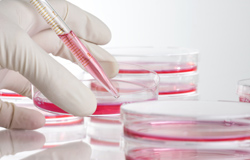Clearing the pathways to anti-cancer therapy
The development of cancer is a web of biochemical events. As a result of the chemical cascades taking place, other cells can come under control of the tumour cells. Consequently, a multitude of genes and enzymes is involved in these developmental pathways. Some of these can be targeted and their progression blocked therefore providing effective cancer therapy. Matrix metalloproteinases (MMPs) have been shown to play a key role in the development of cancer malignancy. As such, previous research has led to their development as tumour therapy agents. Unfortunately, unpleasant side-effects have been recorded in clinical trials. The European project PROFILING MMP INHIBITI therefore aimed to define the role of metalloproteinases at the pathway level in order to elucidate and predict their effects. Depending on structure, members of the group metalloproteinases can have totally opposed roles. As a first step therefore, project partners at the University of Liège in Belgium identified which metalloproteinases were cancer promoters and which had an inhibitory effect. The latter could then be excluded as molecular targets. One promising candidate was MMP14 which acts an angiogenic factor and stimulates the development of new blood supply for the tumour cells. This proteinase acts in concert with two others that are strongly expressed by cancer cells and recruit neutrophil and myofibroblast cells in the development of the cancer. Ironically, these cells usually play a benign role in immunity and wound healing respectively. One valuable outcome of this research is that the data supports a previously held hypothesis regarding cell interaction. The team observed that growth factors can activate MMPs on stromal cells (connective tissue cells) and worse, simultaneous induction of MMP production by the tumour cells. The information from this research has been widely disseminated through scientific journals. This study has illustrated how a cell's role can be distorted depending on its biochemical environment. Key molecules in the pathway from normal tissue to aggressive tumour have also been identified. The design of improved anti-cancer agents is undoubtedly the next step.







